window Acura RLX 2015 Owner's Guide
[x] Cancel search | Manufacturer: ACURA, Model Year: 2015, Model line: RLX, Model: Acura RLX 2015Pages: 521, PDF Size: 22.24 MB
Page 430 of 521
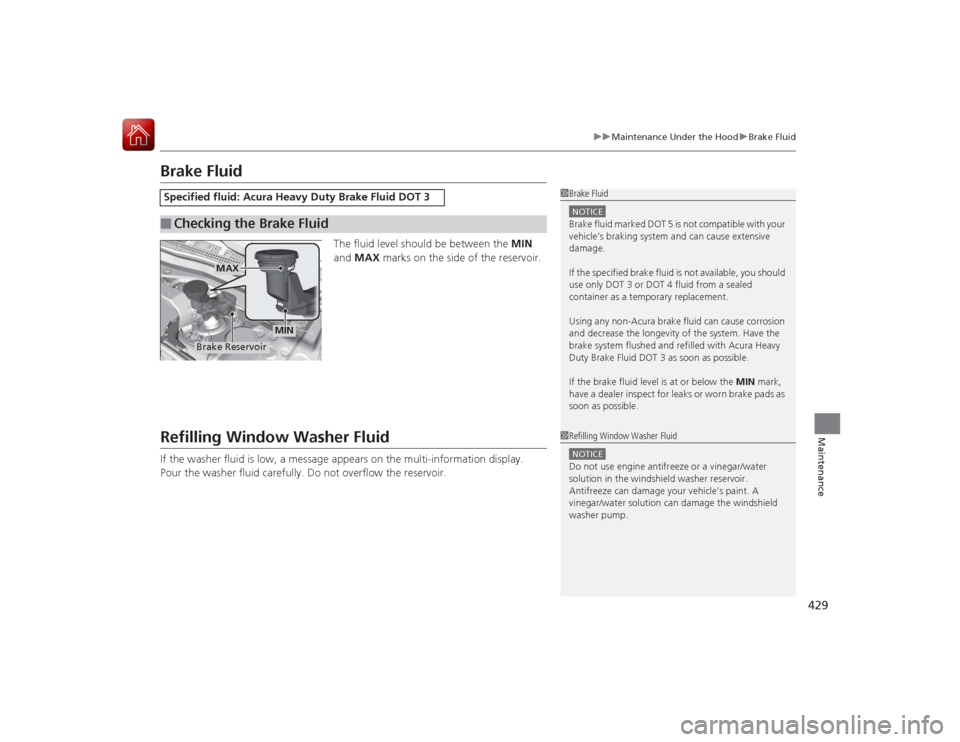
429
uuMaintenance Under the Hood uBrake Fluid
Maintenance
Brake Fluid
The fluid level should be between the MIN
and MAX marks on the side of the reservoir.
Refilling Window Washer FluidIf the washer fluid is low, a message appears on the multi-information display.
Pour the washer fluid carefully. Do not overflow the reservoir.Specified fluid: Acura Heavy Duty Brake Fluid DOT 3■
Checking the Brake Fluid
1Brake FluidNOTICEBrake fluid marked DOT 5 is not compatible with your
vehicle’s braking system and can cause extensive
damage.
If the specified brake fluid is not available, you should
use only DOT 3 or DOT 4 fluid from a sealed
container as a temporary replacement.
Using any non-Acura brake fluid can cause corrosion
and decrease the longevity of the system. Have the
brake system flushed and refilled with Acura Heavy
Duty Brake Fluid DOT 3 as soon as possible.
If the brake fluid level is at or below the MIN mark,
have a dealer inspect for leaks or worn brake pads as
soon as possible.
MIN
MAX
Brake Reservoir
1 Refilling Window Washer FluidNOTICEDo not use engine antifreeze or a vinegar/water
solution in the windshield washer reservoir.
Antifreeze can damage your vehicle’s paint. A
vinegar/water solution can damage the windshield
washer pump.
Page 437 of 521
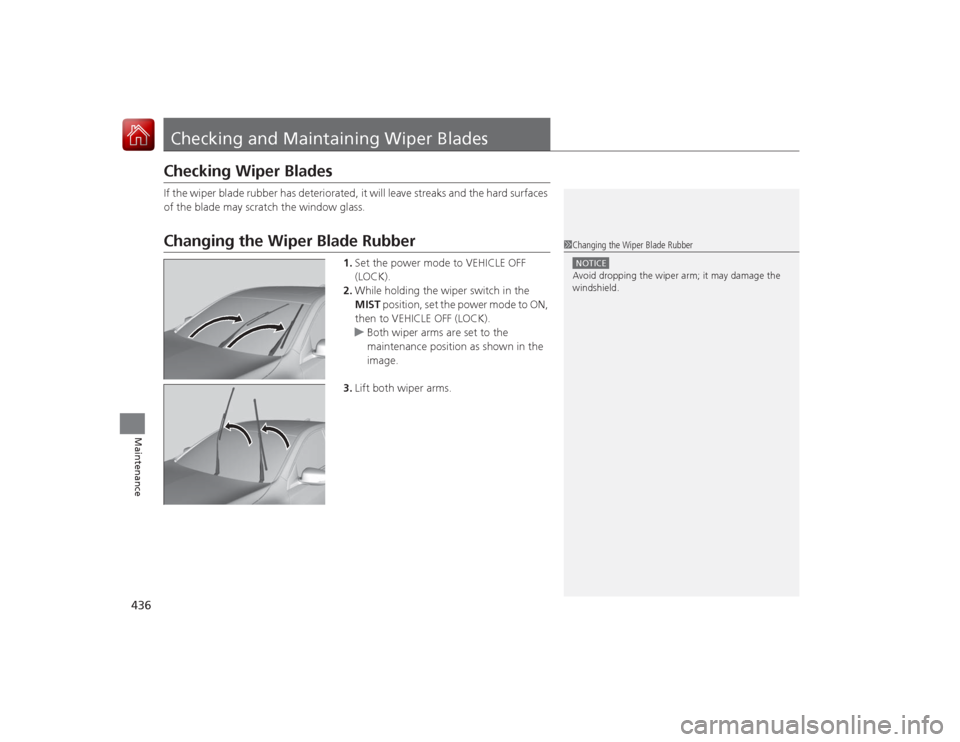
436Maintenance
Checking and Maintaining Wiper BladesChecking Wiper BladesIf the wiper blade rubber has deteriorated, it will leave streaks and the hard surfaces
of the blade may scratch the window glass.Changing the Wiper Blade Rubber
1.Set the power mode to VEHICLE OFF
(LOCK).
2. While holding the wiper switch in the
MIST position, set the power mode to ON,
then to VEHICLE OFF (LOCK).
u Both wiper arms are set to the
maintenance position as shown in the
image.
3. Lift both wiper arms.
1Changing the Wiper Blade RubberNOTICEAvoid dropping the wiper arm; it may damage the
windshield.
Page 449 of 521
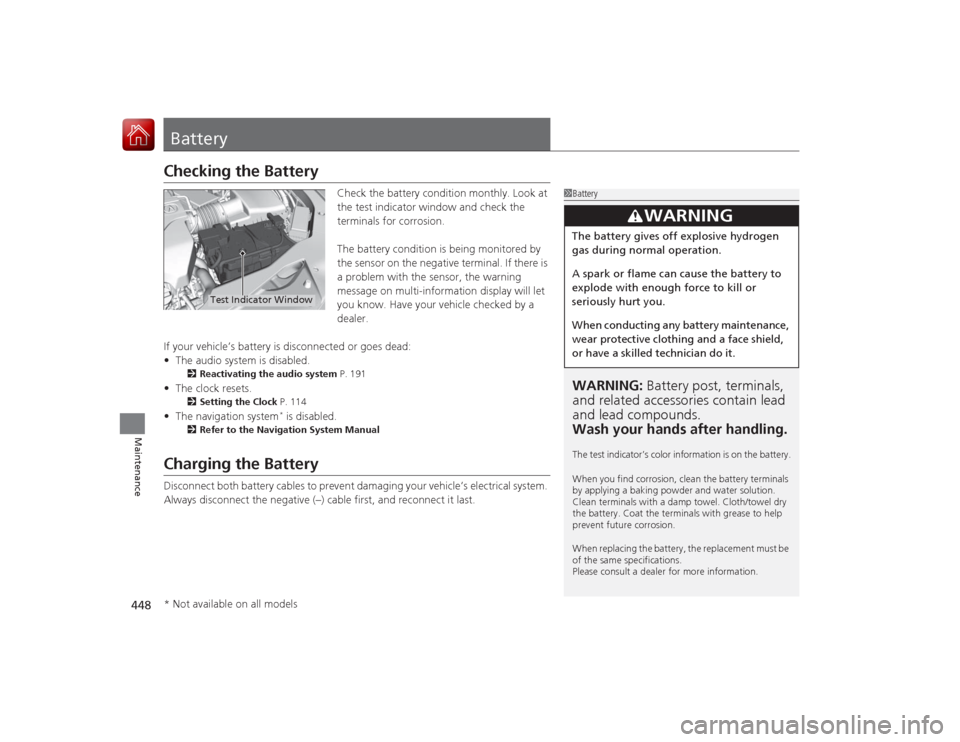
448Maintenance
BatteryChecking the Battery
Check the battery condition monthly. Look at
the test indicator window and check the
terminals for corrosion.
The battery condition is being monitored by
the sensor on the negative terminal. If there is
a problem with the sensor, the warning
message on multi-information display will let
you know. Have your vehicle checked by a
dealer.
If your vehicle’s battery is disconnected or goes dead:
• The audio system is disabled.
2 Reactivating the audio system P. 191
•The clock resets.
2 Setting the Clock P. 114
•The navigation system
* is disabled.
2 Refer to the Navigation System Manual
Charging the BatteryDisconnect both battery cables to prevent damaging your vehicle’s electrical system.
Always disconnect the negative (–) cable first, and reconnect it last.
1BatteryWARNING: Battery post, terminals,
and related accessori es contain lead
and lead compounds.
Wash your hands after handling.The test indicator’s color information is on the battery.
When you find corrosion, clean the battery terminals
by applying a baking powder and water solution.
Clean terminals with a damp towel. Cloth/towel dry
the battery. Coat the termina ls with grease to help
prevent future corrosion.
When replacing the battery, the replacement must be
of the same specifications.
Please consult a dealer for more information.
3
WARNING
The battery gives off explosive hydrogen
gas during normal operation.
A spark or flame can cause the battery to
explode with enough force to kill or
seriously hurt you.
When conducting any battery maintenance,
wear protective clothing and a face shield,
or have a skilled technician do it.
Test Indicator Window
* Not available on all models
Page 451 of 521
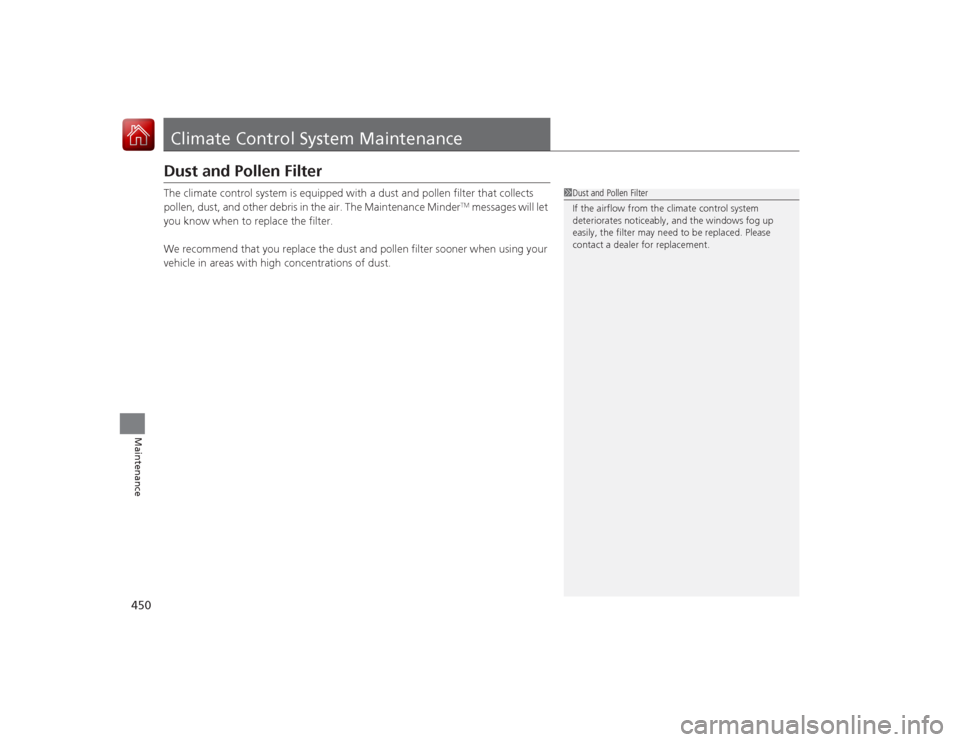
450Maintenance
Climate Control System MaintenanceDust and Pollen FilterThe climate control system is equipped with a dust and pollen filter that collects
pollen, dust, and other debris in the air. The Maintenance Minder
TM messages will let
you know when to replace the filter.
We recommend that you replace the dust and pollen filter sooner when using your
vehicle in areas with high concentrations of dust.
1 Dust and Pollen Filter
If the airflow from the climate control system
deteriorates noticeably, and the windows fog up
easily, the filter may need to be replaced. Please
contact a dealer for replacement.
Page 454 of 521

453
uuCleaning uExterior Care
Continued
Maintenance
Exterior CareDust off the vehicle body after you drive.
Regularly inspect your vehicle for scratches on painted surfaces. A scratch on a
painted surface can result in body rust. If you find a scratch, promptly repair it.
Wash the vehicle regularly. Wash more frequently when driving in the following
conditions:
• If driving on roads with road salt.
• If driving in coastal areas.
• If tar, soot, bird droppings, insects, or tree sap are stuck to painted surfaces.
• Make sure to follow the instructions indicated on the automated car wash.
• Fold in the door mirrors.
• Turn off the automatic intermittent wipers
*.
• Keep sufficient distance between the cleaning nozzle and the vehicle body.
• Take particular care around the windows. Standing too close may cause water to
enter the vehicle interior.
• Do not spray high pressure water directly into the engine compartment. Instead,
use low pressure water and a mild detergent.
A good coat of automotive body wax helps protect your vehicle’s paint from the
elements. Wax will wear off over time and exp ose your vehicle’s paint to the
elements, so reapply as necessary.
■
Washing the Vehicle
■
Using an Automated Car Wash
■
Using High Pressure Cleaners
■
Applying Wax
1 Washing the Vehicle
Do not spray water into the air intake vents. It can
cause a malfunction.
Air Intake Vents
1Applying WaxNOTICEChemical solvents and strong cleaners can damage
the paint, metal, and plastic on your vehicle. Wipe up
spills immediately.
* Not available on all models
Page 455 of 521
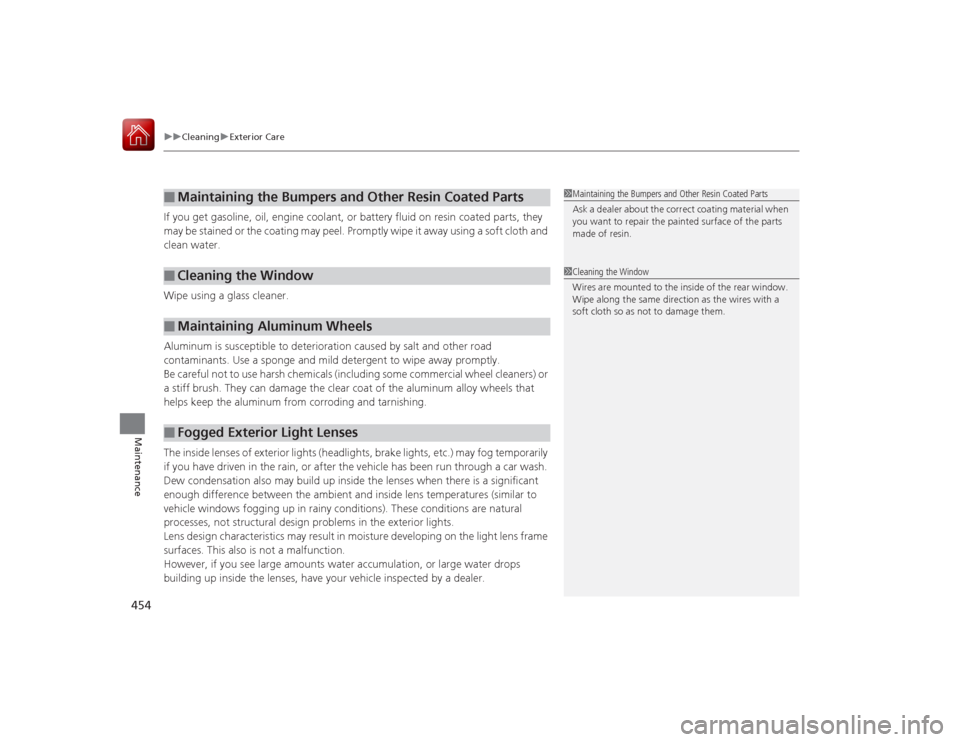
uuCleaning uExterior Care
454Maintenance
If you get gasoline, oil, engine coolant, or battery fluid on resin coated parts, they
may be stained or the coating may peel. Promptly wipe it away using a soft cloth and
clean water.
Wipe using a glass cleaner.
Aluminum is susceptible to deterioration caused by salt and other road
contaminants. Use a sponge and mild detergent to wipe away promptly.
Be careful not to use harsh chemicals (including some commercial wheel cleaners) or
a stiff brush. They can damage the clear coat of the aluminum alloy wheels that
helps keep the aluminum from corroding and tarnishing.
The inside lenses of exterior lights (headlights, brake lights, etc.) may fog temporarily
if you have driven in the rain, or after the vehicle has been run through a car wash.
Dew condensation also may build up inside the lenses when there is a significant
enough difference between the ambient and inside lens temperatures (similar to
vehicle windows fogging up in rainy conditions). These conditions are natural
processes, not structural design problems in the exterior lights.
Lens design characteristics may result in moisture developing on the light lens frame
surfaces. This also is not a malfunction.
However, if you see large amounts water accumulation, or large water drops
building up inside the lenses, have your vehicle inspected by a dealer.■
Maintaining the Bumpers and Other Resin Coated Parts
■
Cleaning the Window
■
Maintaining Aluminum Wheels
■
Fogged Exterior Light Lenses
1Maintaining the Bumpers and Other Resin Coated Parts
Ask a dealer about the correct coating material when
you want to repair the painted surface of the parts
made of resin.1Cleaning the Window
Wires are mounted to the inside of the rear window.
Wipe along the same direction as the wires with a
soft cloth so as not to damage them.
Page 461 of 521

uuIf a Tire Goes Flat uTemporarily Repairing a Flat Tire
460Handling the Unexpected
4. Plug in the compressor to the accessory
power socket.
u Be careful not to pinch the cord in a
door or window.
u Do not plug any other electronic
devices into other accessory power
sockets.
2 Accessory Power Sockets P. 167
5.Start the engine.
u Keep the engine running while injecting
sealant and air.
2 Carbon Monoxide Gas P. 64
6.Turn the selector switch to SEALANT/
AIR .
1Injecting Sealant and AirNOTICEDo not operate the temporary tire repair kit
compressor for more than 15 minutes. The
compressor can overheat and become permanently
damaged.
Until the sealant injection is complete, the pressure
shown on the pressure gauge will appear higher than
actual. After the sealan t injection is complete the
pressure will drop and then begin to rise again as the
tire is inflated with air. This is normal. To accurately
measure the air pressure using the gauge, turn the air
compressor off only after the sealant injection is
complete.
3
WARNING
Running the engine with the vehicle in an
enclosed or even partly enclosed area can
cause a rapid build-up of toxic carbon
monoxide.
Breathing this colorless, odorless gas can
cause unconsciousness and even death.
Only run the engi ne to power the air
compressor with the vehicle outdoors.
SEALANT/AIR side
Page 467 of 521

uuIf a Tire Goes Flat uTemporarily Repairing a Flat Tire
466Handling the Unexpected
7. Plug in the kit to the accessory power
socket.
u Be careful not to pinch the cord in a
door or window.
u Do not plug any other electronic
devices into other accessory power
sockets.
2 Accessory Power Sockets P. 167
8.Start the engine.
u Keep the engine running while injecting
air.
2 Carbon Monoxide Gas P. 64
9.Turn the selector switch to AIR ONLY.
10. Press the inflator switch to turn on the kit.
u The compressor starts to inject air into
the tire.
11. Inflate the tire to the specified air pressure.
1Inflating an Under-inflated Tire
3
WARNING
Running the engine with the vehicle in an
enclosed or even partly enclosed area can
cause a rapid build-up of toxic carbon
monoxide.
Breathing this colorless, odorless gas can
cause unconsciousness and even death.
Only run the engi ne to power the air
compressor with the vehicle outdoors.
AIR ONLY
side
ON
Page 490 of 521
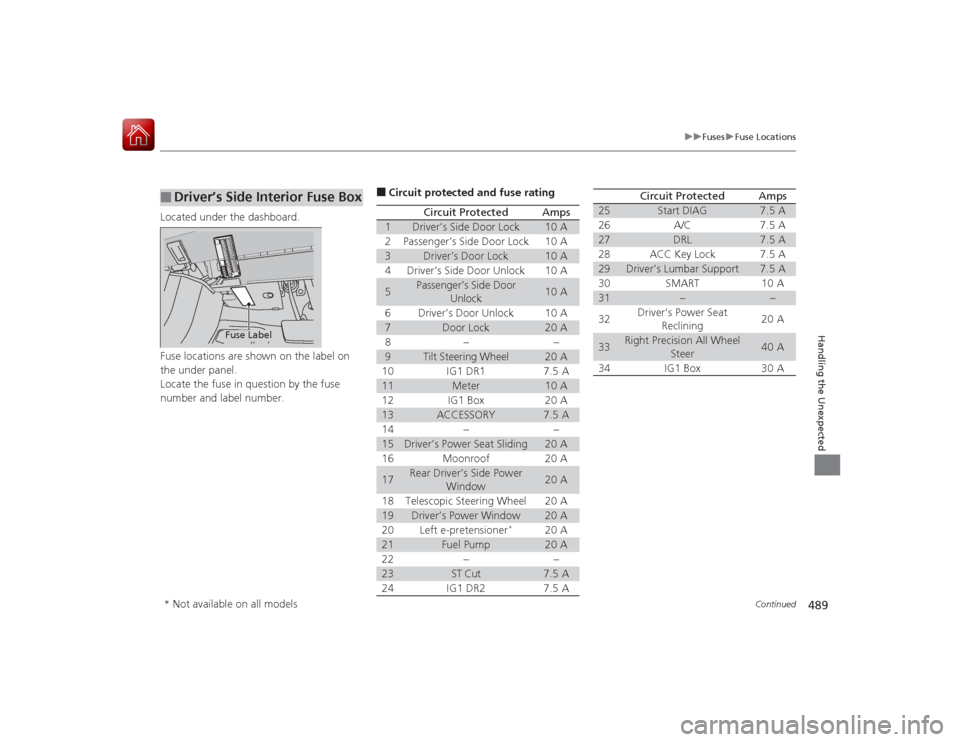
489
uuFuses uFuse Locations
Continued
Handling the Unexpected
Located under the dashboard.
Fuse locations are shown on the label on
the under panel.
Locate the fuse in question by the fuse
number and label number.■
Driver’s Side Interior Fuse Box
Fuse Label
■Circuit protected and fuse rating
Circuit Protected
Amps
1
Driver’s Side Door Lock
10 A
2
Passenger’s Side Door Lock
10 A
3
Driver’s Door Lock
10 A
4
Driver’s Side Door Unlock
10 A
5
Passenger’s Side Door
Unlock
10 A
6
Driver’s Door Unlock
10 A
7
Door Lock
20 A
8
−
−
9
Tilt Steering Wheel
20 A
10
IG1 DR1
7.5 A
11
Meter
10 A
12
IG1 Box
20 A
13
ACCESSORY
7.5 A
14
−
−
15
Driver’s Power Seat Sliding
20 A
16
Moonroof
20 A
17
Rear Driver’s Side Power Window
20 A
18
Telescopic Steering Wheel
20 A
19
Driver’s Power Window
20 A
20
Left e-pretensioner
*
20 A
21
Fuel Pump
20 A
22
−
−
23
ST Cut
7.5 A
24
IG1 DR2
7.5 A
25
Start DIAG
7.5 A
26
A/C
7.5 A
27
DRL
7.5 A
28
ACC Key Lock
7.5 A
29
Driver’s Lumbar Support
7.5 A
30
SMART
10 A
31
−
−
32
Driver’s Power Seat
Reclining
20 A
33
Right Precision All Wheel Steer
40 A
34
IG1 Box
30 A
Circuit Protected
Amps
* Not available on all models
Page 491 of 521

490
uuFuses uFuse Locations
Handling the Unexpected
Located on the lower side panel. Take off
the cover to open.
Fuse locations are shown on the cover.■
Passenger’s Side Interior Fuse
BoxFuse Label
Cover
■Circuit protected and fuse rating
Circuit Protected
Amps
1
−
−
2
Front Seat Heaters/AVS
20 A
3
Rear Passenger’s Side
Power Window
20 A
4
Front Passenger’s Lumbar Support
7.5 A
5
−
−
6
−
−
7
Passenger’s Power Seat Sliding
20 A
8
Passenger’s Power Seat
Reclining
20 A
9
Rear Seat Heaters
*
(20 A)
10
−
−
11
Fly Start
15 A
12
Accessory Power Socket
(Console Compartment)
20 A
13
Accessory Power Socket (Center Pocket)
20 A
14
AS ECU
7.5 A
15
Glove Box
7.5 A
16
−
−
17
−
−
18
Front Passenger’s Power
Window
20 A
19
SRS1
10 A
*1:Except ADVANCE and U.S. TECH-AUDIO models
*2:ADVANCE and U.S. TECH-AUDIO models20
ABS/VSA
7.5 A
21
−
−
22
e-pretensioner
*
(7.5 A)
23
−
−
24
SRS2
7.5 A
25
Illumination
7.5 A
26
Right e-pretensioner
*
(20 A)
27
Heated Steering Wheel
*
10 A
28
Audio AMP
30 A
*1
40 A
*2
Circuit Protected
Amps
* Not available on all models